Original / Odaily Planet Daily
Author / Golem
At 1 AM on August 7, the long-awaited Bitcoin scaling solution RGB protocol finally went live on the mainnet after two years of preparation. To encourage users to experience the RGB protocol on the mainnet, the infrastructure developer Bitlight Labs also launched the test currency RGB on the mainnet. Users can claim RGB through the faucet on the Bitlight Labs official website.
Although RGB is just a test currency, it is essentially the first RGB asset on the Bitcoin mainnet and occupies a symbolically significant token name. Therefore, 24 hours before the RGB protocol went live on the mainnet, tutorials for new token offerings and FOMO sentiments spread widely, with degens rubbing their hands in the dark, making a tough battle seemingly unavoidable.
However, when the RGB protocol actually went live, FOMO immediately turned into FUD, and currently, the progress of the RGB token offering is less than 20%. What caused this shift? Is it still worth participating in the RGB protocol? Odaily Planet Daily will briefly analyze this in this article.
Review of the RGB Protocol
The RGB protocol is one of the hottest smart contract scaling solutions during the Bitcoin ecosystem boom in 2023, but it is also one of the slowest developing scaling solutions. Conceived in 2016, officially developed in 2019, the development work changed hands several times, and in 2023, it regained attention due to strong market demand for Bitcoin scaling. However, the development progress remained slow, leading to the RGB++ protocol successfully taking advantage of the hype in 2024, but RGB++ also did not escape the fate of decline. It was only after the Bitlight Labs team assisted in the RGB development in 2024 that real progress was made, and after a long journey of five years, it finally went live on the mainnet.
As time wore on, for most users, the long development time, excellent team background, obscure complexity, and lengthy deep research reports may be the only remaining impressions of the RGB protocol. These impressions have condensed in their minds into the phrase "impressive," which is why such a large-scale discussion and preparation occurred before the mainnet launch. Therefore, I believe it is necessary to briefly introduce the key points of the RGB protocol in this article.
One-Time Sealing
For the Bitcoin network, the RGB protocol is an off-chain scaling solution that keeps smart contracts and transaction data off-chain, thus inherently possessing Turing completeness, using the Bitcoin mainnet as "security backing."
An important technology in the RGB protocol is one-time sealing, which ensures that the same information can only be used once. The UTXO model of the Bitcoin network is naturally compatible with this technology because each UTXO can only be used once. By encrypting and sealing RGB asset information and contract states within UTXOs, these UTXOs are referred to as containers. When a UTXO is spent, the ownership of the asset and the contract state change, effectively preventing double spending and ensuring the security of the RGB ledger.
Client-Side Validation
Another important technology in the RGB protocol is client-side validation. The transfer of RGB assets is not broadcasted through the Bitcoin mainnet but is conducted by an independent off-chain client. Therefore, whenever a transaction occurs, the client only needs to trace back to verify whether the state related to this transaction is correct, without needing to synchronize and validate all transactions in the network. This enhances the privacy protection of RGB to a certain extent.
The above describes how the RGB protocol conducts asset transfers and ensures security through two important technologies. As for how to write smart contracts off-chain and the advantages and disadvantages compared to EVM, that is not the focus for users.
How to Participate in the First RGB Token Offering on the Mainnet
The RGB protocol may be complex in principle, but the token offering activity on the mainnet is very simple. It is essentially an airdrop distribution model where users transfer funds to the project party, and then the project party distributes RGB tokens to users in order. Because a lock order model is used, the same wallet cannot claim again until the distribution is complete, effectively avoiding network congestion.
As of now, there is a total of 21 million RGB tokens, and since each claim is limited to 50 tokens and the distribution is slow, the claiming progress is less than 20%. The community calculates that based on the Bitcoin network's block generation speed, it will take at least 17 hours to complete the claims. Therefore, everyone still has a chance, and here is the specific tutorial for the token offering.
Create a Bitlight Wallet and Transfer BTC
First, download the Bitlight plugin wallet, then create a new wallet. Transfer 0.0003-0.0005 BTC from another address to the wallet; you don't need too much. It is best not to choose to import an old wallet to avoid asset loss due to incompatibility of various wallet asset protocols.
Create a Container
Next, we need to create an RGB UTXO, which is the container for storing RGB assets. First, click on "UTXOs" in the wallet, as shown in the image below.
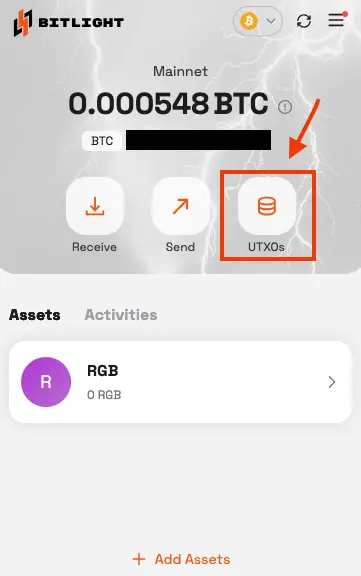
Then click "Create UTXO" in the upper right corner,
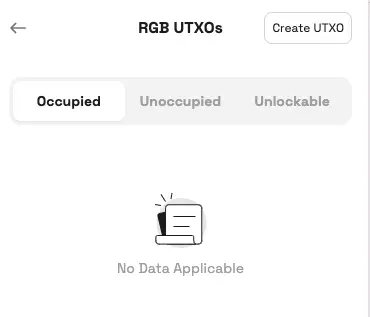
Click "Custom" to customize the amount of Bitcoin contained in the UTXO. Since this UTXO serves as an RGB asset container, it does not require too much Bitcoin; 0.0001 BTC is sufficient. Then select an appropriate fee rate, click next, and sign to complete the process.
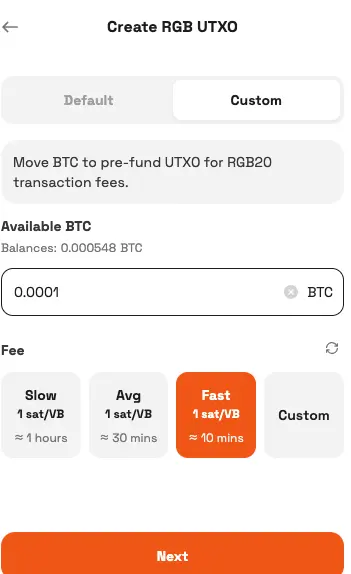
It is advisable not to create many containers in succession, as creating containers requires paying Bitcoin network gas fees, and unlocking containers (turning them into normally usable UTXOs) also requires gas fees. Moreover, since this token offering uses a lock order model and the distribution speed is extremely slow, creating multiple UTXOs in advance does not add much value and instead increases costs.
Claim RGB Tokens
After the transaction for creating the container is confirmed, go to the Bitlight official website, link your wallet, and click Claim. As shown in the image below, once a wallet claims, the user cannot continue to operate and must wait for the "Claiming" to finish before proceeding to the next claim.
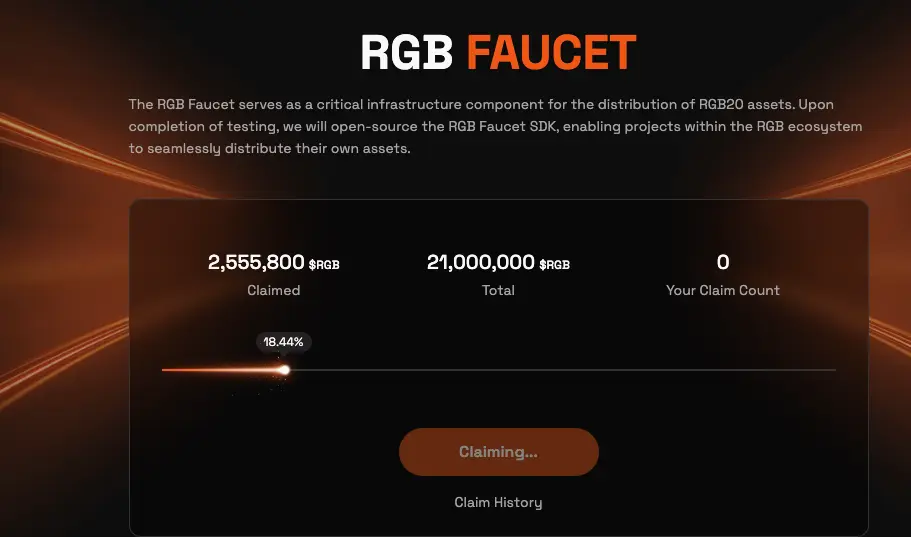
From FOMO to FUD
The token offering activity for the RGB mainnet was relatively smooth, but it still faced strong FUD from the community. The reasons are as follows:
Too Few RGB Tokens Minted at a Time
The total amount of RGB tokens is 21 million, and the project party strictly stipulates that only 50 tokens are distributed per claim. Therefore, it will require 420,000 transactions to mint all RGB tokens. Even if we calculate 4,000 transactions per block, it will take 105 blocks to complete, approximately 17.5 hours.
As a result, the community complains that the project party has stretched the timeline too long, which will exhaust market sentiment and enthusiasm.
Project Party Charges Fees
Another reason for the FUD surrounding RGB is the fees charged by Bitlight Labs. According to on-chain information, each claim transaction requires users to transfer 0.00003636 BTC (about 4 USD) to a fixed address. Therefore, for 420,000 claims, the project party could collect about 1.68 million USD.

A claim transaction for RGB tokens
Although the project party later explained that these fees would cover future transaction costs for distributing RGB assets and serve as market-making and buyback fees, planning is one thing, and collecting money is another. Many players still find it hard to believe the project party.
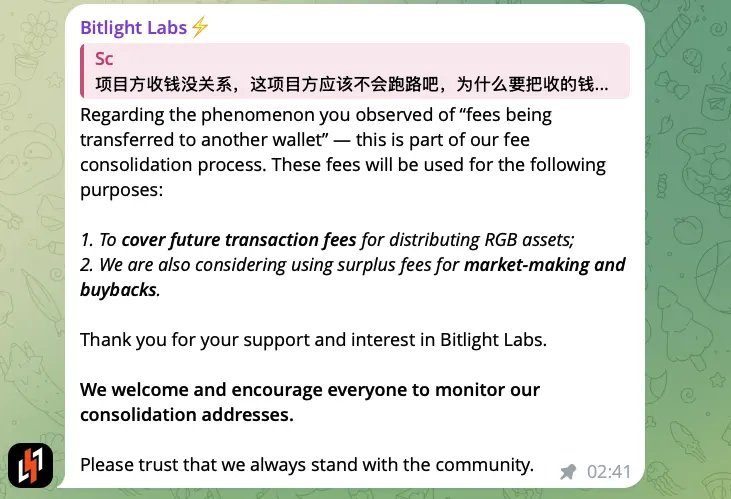
Moreover, the 1.68 million USD fee, combined with the gas fees for users to create containers and transactions, raises the estimated market value of the first RGB token to around 2 million USD. Given the current capital stock and enthusiasm in the Bitcoin ecosystem, 2 million USD is not a low valuation. This may be the real reason for the FUD among most players.
In Conclusion
The attention drawn by the RGB protocol has surprised me. Besides the familiar faces always at the forefront of "losing money on new Bitcoin protocols," many users who usually do not pay much attention to the Bitcoin ecosystem have also participated.
Recently, the Bitcoin ecosystem has been lively again, with a new wave of entrepreneurial projects for new protocols. From spark, BRC 2.0, rune 2.0, labitu to the current RGB, there may be some you are not familiar with, but there is no need to worry; you may have only missed the opportunity to lose money.
New protocols are emerging one after another, each carrying a clichéd yet grand narrative. However, the reality is that most projects remain stuck in early concepts or airdrop parties, with very few truly landing. The vitality of innovation is indeed important, but the current pace resembles a high-speed industrial assembly line.
The player community remains unchanged, repeatedly flooding into one "new protocol carnival" after another, with wealth being harvested and circulated among these people, resembling a subculture group that is not mainstream but formed by a shared belief and a passion intertwined with technology and gambling.
In a world where Bitcoin is already well-known, thinking of a group of people who entertain themselves within it, how can it not be called magical?
免责声明:本文章仅代表作者个人观点,不代表本平台的立场和观点。本文章仅供信息分享,不构成对任何人的任何投资建议。用户与作者之间的任何争议,与本平台无关。如网页中刊载的文章或图片涉及侵权,请提供相关的权利证明和身份证明发送邮件到support@aicoin.com,本平台相关工作人员将会进行核查。




